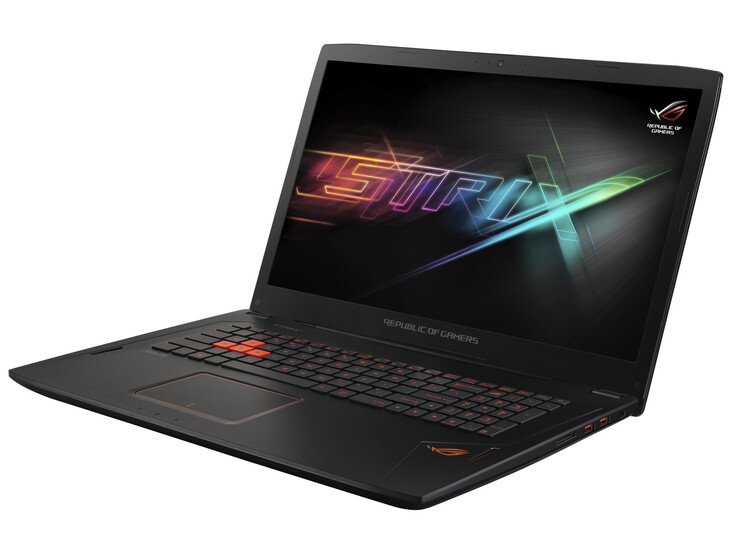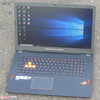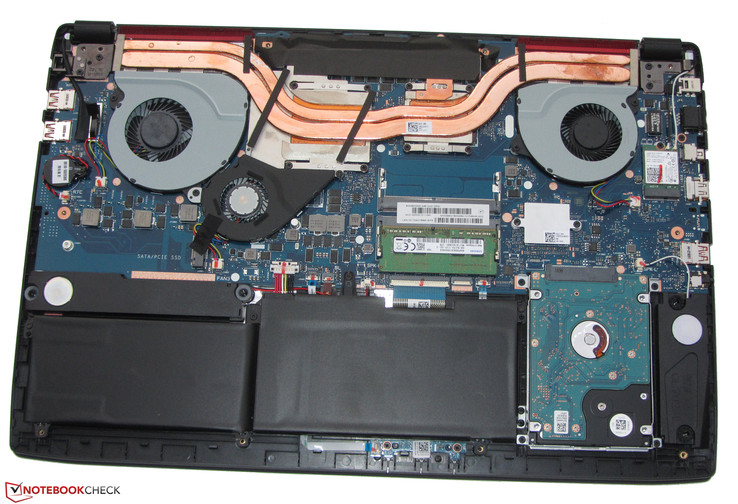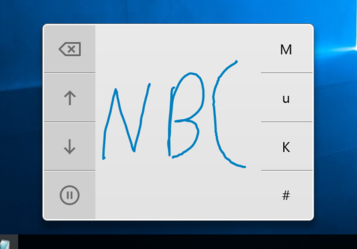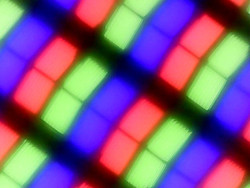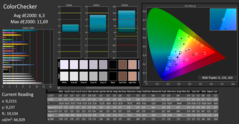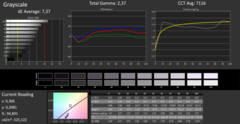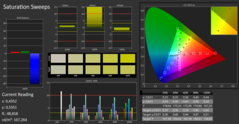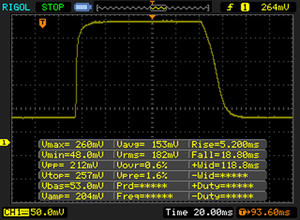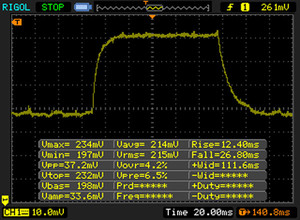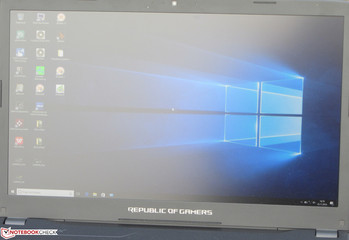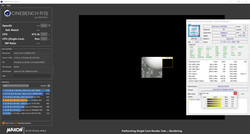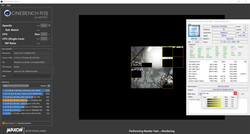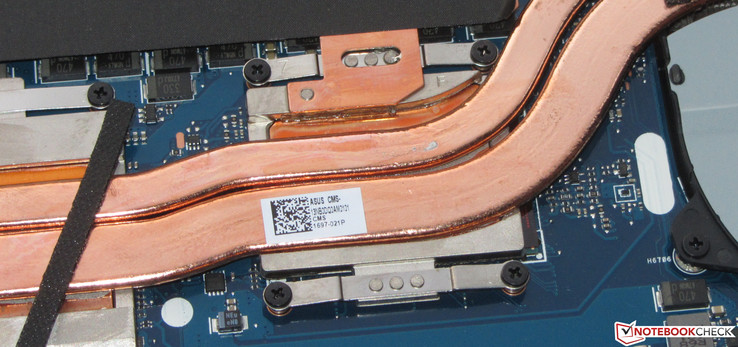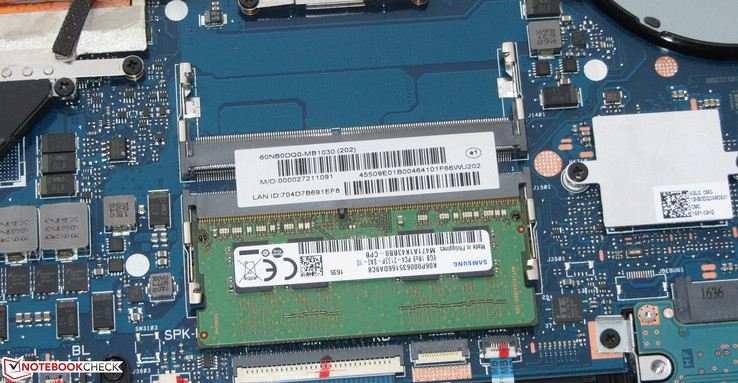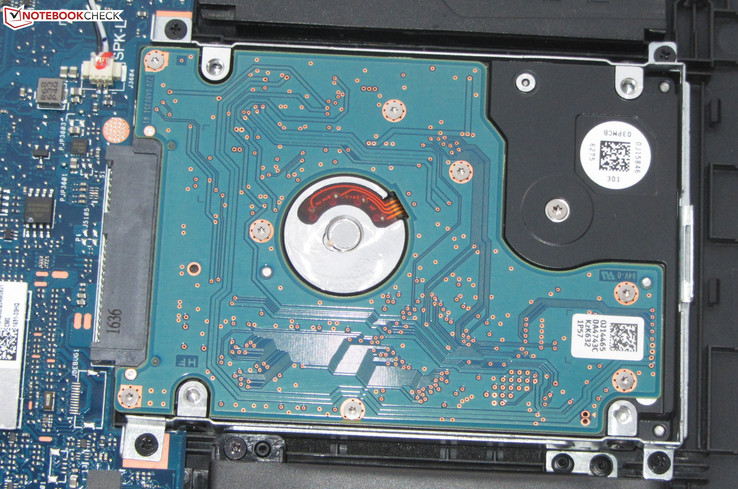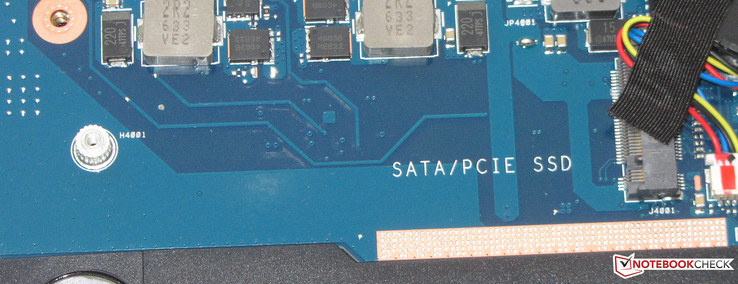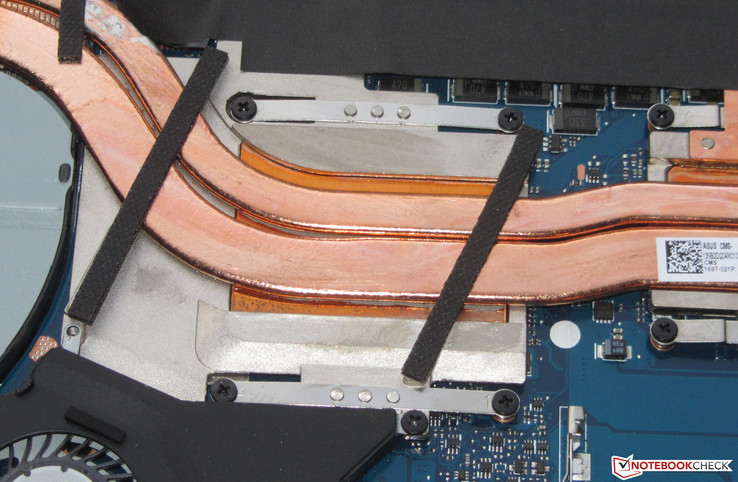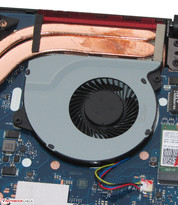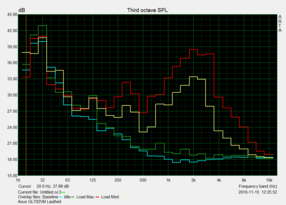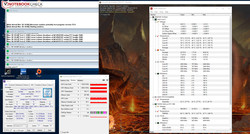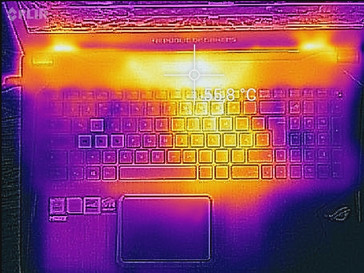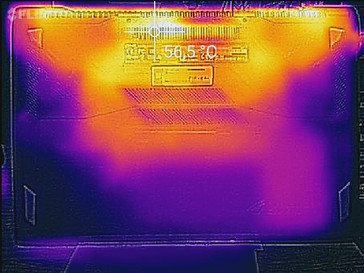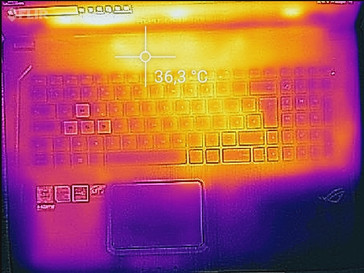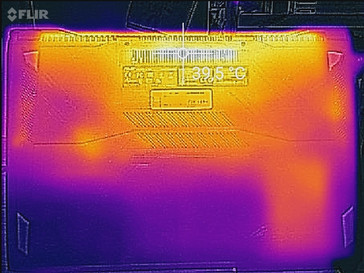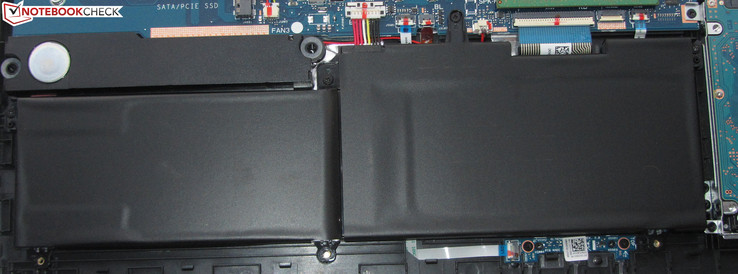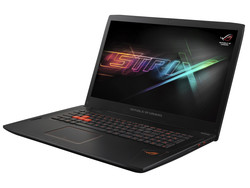Asus GL702VM-GC102D Notebook Review

For the original German review, see here.
With the GL702VM, Asus has a slim 17.3-inch gaming laptop in its lineup. Inside is not only Intel's quad-core processor of the Skylake generation, but also a GeForce GTX 1060 graphics core from Nvidia. The latter brings a significant performance improvement compared to its predecessor (GeForce GTX 960M). This means the Asus notebook is equipped for all current games and titles for the next few years. The GL702VM's competitors are the HP Omen 17, the MSI GS73VR 6RF, the Gigabyte P57X v6 among others.
Case
Asus uses a black, relatively slim case. Highlights are created with red elements. A large part of the case is made of plastic. Only the back of the lid is made of brushed metal. The back is quite prone to fingerprints. The upper side of the base unit is also provided with a texture simulating brushed metal. The battery is built in. The laptop lacks a maintenance hatch. To access the hardware, you would have to remove the bottom shell. More on that later.
Overall, the device is well made. The gap dimensions are correct. The only problem: Some material overhang of the display bezel can be felt on the left and right side of the lid. The base unit can be slightly bent on both sides of the keyboard and below the touchpad. Additionally, the base unit can be twisted too easily for our taste. We expect greater stiffness from a device in this price range. The lid can also be twisted slightly, but this does not result in image distortion. The latter occur when pressure is applied to the back of the lid, however, only in a few places. The hinges hold the lid firmly in position. It is possible to open the lid with one hand.
The weight and dimensions of the Asus notebook are approximately on par with its rivals like the MSI GS73VR 6RF. Devices like the HP Omen 17 and the Gigabyte P57X v6 are bigger and heavier since their more powerful graphics cores require more massive coolers and more volume for air circulation.
Connectivity
Asus delivers a good selection of ports: Three USB 3.0 (Type-A) ports are on board. There are also two video outputs and a Thunderbolt 3 port. This means you can connect up to three displays to the laptop. The port layout is nice; they are placed towards the rear on both sides.
SD Card Reader
The GL702VM's SD card reader is one of the faster models. When copying large files, it achieves a maximum transfer rate of 84.6 MB/s. The transfer of 250 .jpg image files (each around 5 MB) is handled at a speed of 72.6 MB/s. The readers of the competition are on par - the only exception being the MSI GS73VR 6RF. We test memory-card readers with a reference card (Toshiba Exceria Pro SDXC 64 GB UHS-II).
| SD Card Reader | |
| average JPG Copy Test (av. of 3 runs) | |
| Schenker XMG P507 | |
| Gigabyte P57X v6 | |
| HP Omen 17-w110ng | |
| Asus GL702VM-GC102D | |
| MSI GS73VR 6RF | |
| maximum AS SSD Seq Read Test (1GB) | |
| Gigabyte P57X v6 | |
| HP Omen 17-w110ng | |
| Schenker XMG P507 | |
| Asus GL702VM-GC102D | |
| MSI GS73VR 6RF | |
Communication
The Asus notebook carries a WLAN module with an Intel chip (7265). In addition to the Wi-Fi standards 802.11a/b/g/n, it also supports the fast AC standard. Under optimal circumstances (no other WLAN devices nearby, short distance between the notebook and the server PC) we measured excellent transfer speeds. The results of the laptop's rivals are more or less on the same level in this regard as well. The wired network connections are handled by a Gigabit Ethernet chip from Realtek's RTL8168/8111 family. Representatives of this series are encountered in many notebooks. The chip accomplishes its tasks smoothly.
| Networking | |
| iperf Server (receive) TCP 1 m | |
| HP Omen 17-w110ng | |
| Asus GL702VM-GC102D (jseb) | |
| Schenker XMG P507 | |
| MSI GS73VR 6RF | |
| iperf Client (transmit) TCP 1 m | |
| Asus GL702VM-GC102D (jseb) | |
| MSI GS73VR 6RF | |
| HP Omen 17-w110ng | |
| Schenker XMG P507 | |
Webcam
Accessories
Included with the laptop is a USB mouse. Our review unit also came with a driver DVD, since no Windows operating system was available. The usual documents (quick-start poster, warranty information) are also included.
Maintenance
To access the hardware, you have to take off the bottom shell of the laptop. This requires removing the screws on the bottom. Afterwards, the bottom shell is removed with a spreader. This gives you access to the memory slots, the hard drive, the unoccupied M.2 slot, the three fans, the BIOS battery, and the WLAN module.
Warranty
Asus gives the GL702VM a two-year warranty - including pick-up service. The time span can be expanded to three years for about 70 Euros (~$74).
Please see our Guarantees, Return Policies & Warranties FAQ for country-specific information.
Input Devices
Keyboard
Asus equips the GL702VM with a chiclet keyboard illuminated in red. The backlight has three brightness levels, which can be chosen with two function keys. The flat keys have a medium travel and a clear pressure point. Their resistance could be a bit firmer for our taste. While typing, the keyboard gives in in the middle. This results in a somewhat spongy typing feel. If you write a lot, this is not the keyboard for you. However, it suffices for the requirements of home use.
Touchpad
The multi-touch capable click pad takes up a space of approximately 10.5 x 7.3 cm (~4.1 x 2.9 in). This gives plenty of space for using gesture controls. The various gestures can be individually turned on and off in the configuration menu. The pad's smooth surface does not hinder the fingers while gliding. It also registers input in the corners. The pad has a shallow travel and a pressure point that can be heard and felt. The click pad can also be used for handwritten input. Asus supplies the laptop with the "Touchpad Handwriting" software for this purpose.
We did encounter one problem: The right mouse key does not function reliably. It functions for a while, and then, after turning the laptop on the next time, it does not work. We could not find a reason for this behavior. A reinstallation of the driver did not solve the problem, which is also present on the 15.6-inch version of the GL702VM - the Asus GL502VM (a review of this notebook will be published in the next few days on Notebookcheck.com). Thus, it does not appear to be a unique problem affecting only our current review unit.
Display
The GL702VM features a matte 17.3-inch display with a native resolution of 1920x1080 pixels. According to the Asus webpage, this is the only available display model. The screens brightness (311.9 cd/m²) is decent, but the contrast (652:1) should be higher. On a positive note: The display never exhibits PWM flickering.
The display supports Nvidia's G-Sync technology, through which the frame rate of the screen and the GPU are dynamically adjusted to each other. This is supposed to create as smooth images as possible - especially with computer games - without display errors.
| |||||||||||||||||||||||||
Brightness Distribution: 91 %
Center on Battery: 326 cd/m²
Contrast: 652:1 (Black: 0.5 cd/m²)
ΔE ColorChecker Calman: 6.3 | ∀{0.5-29.43 Ø4.78}
ΔE Greyscale Calman: 7.37 | ∀{0.09-98 Ø5}
83% sRGB (Argyll 1.6.3 3D)
55% AdobeRGB 1998 (Argyll 1.6.3 3D)
61.1% AdobeRGB 1998 (Argyll 3D)
83.5% sRGB (Argyll 3D)
65.1% Display P3 (Argyll 3D)
Gamma: 2.37
CCT: 7116 K
| Asus GL702VM-GC102D IPS, 1920x1080, 17.3" | HP Omen 17-w110ng IPS, 1920x1080, 17.3" | Gigabyte P57X v6 IPS, 1920x1080, 17.3" | MSI GS73VR 6RF TN LED, 1920x1080, 17.3" | Schenker XMG P507 IPS, 60 Hz, 1920x1080, 15.6" | |
|---|---|---|---|---|---|
| Display | 1% | 5% | 32% | -0% | |
| Display P3 Coverage (%) | 65.1 | 66.6 2% | 68 4% | 90 38% | 64.5 -1% |
| sRGB Coverage (%) | 83.5 | 84.1 1% | 87.5 5% | 99.9 20% | 83.4 0% |
| AdobeRGB 1998 Coverage (%) | 61.1 | 61.5 1% | 64 5% | 83.6 37% | 61 0% |
| Response Times | -1% | 1% | 42% | 3% | |
| Response Time Grey 50% / Grey 80% * (ms) | 38 ? | 37 ? 3% | 33.6 ? 12% | 28 ? 26% | 36 ? 5% |
| Response Time Black / White * (ms) | 23 ? | 24 ? -4% | 25.6 ? -11% | 9.6 ? 58% | 23 ? -0% |
| PWM Frequency (Hz) | |||||
| Screen | 24% | 17% | 33% | 14% | |
| Brightness middle (cd/m²) | 326 | 362 11% | 329.2 1% | 337.2 3% | 288 -12% |
| Brightness (cd/m²) | 312 | 342 10% | 321 3% | 315 1% | 292 -6% |
| Brightness Distribution (%) | 91 | 87 -4% | 93 2% | 86 -5% | 87 -4% |
| Black Level * (cd/m²) | 0.5 | 0.31 38% | 0.267 47% | 0.308 38% | 0.3 40% |
| Contrast (:1) | 652 | 1168 79% | 1233 89% | 1095 68% | 960 47% |
| Colorchecker dE 2000 * | 6.3 | 4.5 29% | 5.93 6% | 2.96 53% | 5.1 19% |
| Colorchecker dE 2000 max. * | 11.69 | 9.31 20% | 11.07 5% | 5.45 53% | 9.44 19% |
| Greyscale dE 2000 * | 7.37 | 3.48 53% | 6.72 9% | 2.57 65% | 4.43 40% |
| Gamma | 2.37 93% | 2.23 99% | 2.12 104% | 2.25 98% | 2.46 89% |
| CCT | 7116 91% | 6144 106% | 7611 85% | 7114 91% | 6687 97% |
| Color Space (Percent of AdobeRGB 1998) (%) | 55 | 55 0% | 57 4% | 74.3 35% | 55 0% |
| Color Space (Percent of sRGB) (%) | 83 | 84 1% | 87 5% | 100 20% | 83 0% |
| Total Average (Program / Settings) | 8% /
16% | 8% /
12% | 36% /
34% | 6% /
10% |
* ... smaller is better
Screen Flickering / PWM (Pulse-Width Modulation)
| Screen flickering / PWM not detected | ||
In comparison: 53 % of all tested devices do not use PWM to dim the display. If PWM was detected, an average of 8149 (minimum: 5 - maximum: 343500) Hz was measured. | ||
The laptop's display shows a DeltaE-2000 color deviation of 6.3 in default settings. A result below 3 should be aimed for. The screen does not suffer from a blue tint. Using the color profile we provide, the color and grayscale reproduction can be improved. The color spaces AdobeRGB and sRGB cannot be displayed. The coverage rates amount to 55% (AdobeRGB) and 83% (sRGB).
Display Response Times
| ↔ Response Time Black to White | ||
|---|---|---|
| 23 ms ... rise ↗ and fall ↘ combined | ↗ 5 ms rise | |
| ↘ 18 ms fall | ||
| The screen shows good response rates in our tests, but may be too slow for competitive gamers. In comparison, all tested devices range from 0.1 (minimum) to 240 (maximum) ms. » 50 % of all devices are better. This means that the measured response time is worse than the average of all tested devices (20.3 ms). | ||
| ↔ Response Time 50% Grey to 80% Grey | ||
| 38 ms ... rise ↗ and fall ↘ combined | ↗ 12 ms rise | |
| ↘ 26 ms fall | ||
| The screen shows slow response rates in our tests and will be unsatisfactory for gamers. In comparison, all tested devices range from 0.165 (minimum) to 636 (maximum) ms. » 54 % of all devices are better. This means that the measured response time is worse than the average of all tested devices (31.7 ms). | ||
Performance
With the GL702VM, Asus delivers a 17.3-inch gaming laptop that can display all current games smoothly. We are reviewing the least expensive (1399 Euros) model of the series. A Windows operating system is not included. If you invest almost 1800 Euros (~$1904), you get the best model of the series with an SSD, HDD and 16 GB of RAM.
Processor
The GL702VM sports an Intel Core i7-6700HQ (Skylake) quad-core processor. It is a representative of top range CPUs. This model can be found in many gaming laptops, because it offers a lot of processing power, but still manages to maintain relatively low power consumption. The CPU also offers more than enough performance for applications besides computer games. With a TDP of 45 watts, the processor is three leagues above ULV-CPUs (15 watts). The Core i7 works with a base speed of 2.6 GHz. Turbo can raise the clock speed to 3.1 GHz (four cores), 3.3 GHz (two cores), or 3.5 GHz (one core); this works while charging as well as on battery power. However, it is not used as aggressively as with other notebooks. This is why the results of our CPU test are slightly worse than those of comparable laptops.
The built-in 6700HQ does not exceed the performance of its Broadwell predecessor (Core i7-5700HQ). Maxing out the Turbo Boost would result in a draw: The Skylake processor would have s slight advantage in single thread applications thanks to the improvements in its Skylake architecture. The Broadwell model would perform better with multithread applications due to its higher Turbo speeds. Since the processor built into the GL702VM does not use its Turbo as aggressively as we have seen in other notebooks, it somewhat lags behind its predecessor in CPU tests.
The Kaby-Lake successor (Core i7-7700HQ) anticipated in 2017 should differ significantly from the 5700HQ and the 6700HQ because of its higher processing speed. This was the case with all the Kaby-Lake processors we have tested so far.
| Cinebench R10 | |
| Rendering Multiple CPUs 32Bit | |
| HP Omen 17-w110ng | |
| Asus GL702VM-GC102D | |
| MSI GS73VR 6RF | |
| Rendering Single 32Bit | |
| HP Omen 17-w110ng | |
| Asus GL702VM-GC102D | |
| MSI GS73VR 6RF | |
| Geekbench 3 | |
| 32 Bit Single-Core Score | |
| Asus GL702VM-GC102D | |
| 32 Bit Multi-Core Score | |
| Asus GL702VM-GC102D | |
| Geekbench 4.0 | |
| 64 Bit Single-Core Score | |
| Asus GL702VM-GC102D | |
| 64 Bit Multi-Core Score | |
| Asus GL702VM-GC102D | |
| JetStream 1.1 - Total Score | |
| HP Omen 17-w110ng | |
| Gigabyte P57X v6 | |
| Asus GL702VM-GC102D | |
| MSI GS73VR 6RF | |
System Performance
The system works well and without hiccups. We did not encounter any problems. The results of the PCMark benchmark are very good. A look at our diagram shows that the results of the competition are approximately the same. There is no noticeable difference between the notebooks in everyday use. Increasing the system performance of the Asus laptop is possible. An M.2 SSD can be installed in the notebook. If you use it as the system drive, the system operates quicker and loading times are shorter. It is also possible to install a second RAM module.
| PCMark 7 Score | 4114 points | |
| PCMark 8 Home Score Accelerated v2 | 4670 points | |
| PCMark 8 Creative Score Accelerated v2 | 6361 points | |
| PCMark 8 Work Score Accelerated v2 | 4809 points | |
Help | ||
| PCMark 8 | |
| Home Score Accelerated v2 | |
| HP Omen 17-w110ng | |
| Asus GL702VM-GC102D | |
| Gigabyte P57X v6 | |
| MSI GS73VR 6RF | |
| Work Score Accelerated v2 | |
| HP Omen 17-w110ng | |
| Gigabyte P57X v6 | |
| Asus GL702VM-GC102D | |
| MSI GS73VR 6RF | |
Storage Devices
When it comes to storage, you will not run out of it very quickly: A 1TB hard drive working at 7,200 RPM is built into the laptop. HDDs like these are almost exclusively found in gaming and business notebooks these days. The transfer rates of the HDD are at a normal level for 7,200 models and are about 15-20% better than those of 5,400 models.
There is also the option of installing an SSD. In the case is an unoccupied M.2 slot (2280), which can host a corresponding SSD. It does not have to be an SATA model, NVMe works too.
| Asus GL702VM-GC102D HGST Travelstar 7K1000 HTS721010A9E630 | MSI CX72-7QLi581 WDC Scorpio Blue WD10JPVX-22JC3T0 | HP Omen 17-w110ng Samsung PM951 NVMe MZVLV256 | Gigabyte P57X v6 Transcend MTS800 256GB M.2 (TS256GMTS800) | MSI GS73VR 6RF SanDisk SD8SN8U1T001122 | |
|---|---|---|---|---|---|
| CrystalDiskMark 3.0 | -20% | 12718% | 7576% | 5569% | |
| Read Seq (MB/s) | 134.6 | 102.8 -24% | 1156 759% | 481.7 258% | 334.3 148% |
| Write Seq (MB/s) | 130.6 | 100.2 -23% | 294.9 126% | 315.4 142% | 319 144% |
| Read 512 (MB/s) | 44.85 | 34.83 -22% | 616 1273% | 303.1 576% | 242.3 440% |
| Write 512 (MB/s) | 63.3 | 46.87 -26% | 294.7 366% | 314.4 397% | 254.4 302% |
| Read 4k (MB/s) | 0.602 | 0.422 -30% | 42.7 6993% | 25.93 4207% | 20.3 3272% |
| Write 4k (MB/s) | 1.146 | 1.063 -7% | 153.3 13277% | 84.6 7282% | 42.51 3609% |
| Read 4k QD32 (MB/s) | 1.106 | 0.918 -17% | 600 54150% | 273.9 24665% | 251.6 22649% |
| Write 4k QD32 (MB/s) | 1.186 | 1.064 -10% | 295.3 24799% | 274.9 23079% | 167.1 13989% |
Graphics Card
The Core i7-6700HQ processor brings along Intel's integrated HD Graphics 530. However, Asus deactivated the GPU. The dedicated GeForce GTX 1060 graphics core therefore works all the time. The GPU is Nvidia's current entry-level model of their high-end GPUs. The core is based on Pascal architecture and supports DirectX 12. It is assisted by 6.144 MB GDDR5 graphics memory. The model in our review unit achieves speeds of up to 1.886 MHz. The results in the 3DMark benchmarks are at a normal level for this GPU. The core significantly beats its predecessor (GeForce GTX 960M).
| 3DMark 06 Standard Score | 19244 points | |
| 3DMark 11 Performance | 11159 points | |
| 3DMark Ice Storm Standard Score | 113032 points | |
| 3DMark Cloud Gate Standard Score | 22619 points | |
| 3DMark Fire Strike Score | 9432 points | |
| 3DMark Fire Strike Extreme Score | 5067 points | |
| 3DMark Time Spy Score | 3536 points | |
Help | ||
| 3DMark 11 - 1280x720 Performance GPU | |
| Gigabyte P57X v6 | |
| HP Omen 17-w110ng | |
| MSI RX 470 Gaming X 4GB | |
| MSI GS73VR 6RF | |
| XMG P723 Pro | |
| Asus GL702VM-GC102D | |
| Schenker XMG P507 | |
| XFX RX-460P4DFG5 Double Dissipation 4 GB | |
| MSI GL72 6QF | |
| 3DMark | |
| 1280x720 Cloud Gate Standard Graphics | |
| HP Omen 17-w110ng | |
| Gigabyte P57X v6 | |
| Asus GL702VM-GC102D | |
| XMG P723 Pro | |
| Schenker XMG P507 | |
| MSI GS73VR 6RF | |
| MSI RX 470 Gaming X 4GB | |
| XFX RX-460P4DFG5 Double Dissipation 4 GB | |
| MSI GL72 6QF | |
| 1920x1080 Fire Strike Graphics | |
| HP Omen 17-w110ng | |
| MSI RX 470 Gaming X 4GB | |
| MSI GS73VR 6RF | |
| Asus GL702VM-GC102D | |
| XMG P723 Pro | |
| Schenker XMG P507 | |
| XFX RX-460P4DFG5 Double Dissipation 4 GB | |
| MSI GL72 6QF | |
Gaming Performance
As a representative of the "Republic of Gamers", the GL702VM can handle computer games. The notebook smoothly displays practically all current games in Full HD resolution and with high quality settings. Even the maximum quality settings can be chosen in many cases. Of all the games we tested, the only exception was X-Plane. Gaming in 4K is also possible, but the choice of corresponding titles is limited. In addition, this would necessitate an appropriate external display, since the GL702VM is only available with a Full HD resolution. If you wish to play more 4K games, you should get a laptop with a GeForce GTX 1070 or even a GTX 1080 core.
| low | med. | high | ultra | |
|---|---|---|---|---|
| Tomb Raider (2013) | 344.9 | 325.4 | 286.2 | 138.4 |
| BioShock Infinite (2013) | 195.1 | 177.3 | 166.4 | 98.9 |
| Battlefield 4 (2013) | 180.1 | 167.2 | 151.4 | 99.1 |
| X-Plane 10.25 (2013) | 81.8 | 46.6 | 24.5 | 24.5 |
| Middle-earth: Shadow of Mordor (2014) | 147.5 | 130.9 | 109 | 85.7 |
| GTA V (2015) | 122.3 | 117.7 | 90.3 | 48.2 |
| Ashes of the Singularity (2016) | 51.2 | 49.1 | 47.5 | |
| Deus Ex Mankind Divided (2016) | 65 | 61.9 | 48.7 | 27.3 |
| FIFA 17 (2016) | 232.7 | 216.2 | 198.6 | 197.9 |
| Mafia 3 (2016) | 51.3 | 47.1 | 40.1 | |
| Battlefield 1 (2016) | 116.4 | 104.9 | 87.4 | 79 |
| Farming Simulator 17 (2016) | 209.3 | 179.6 | 165.1 | 153.9 |
| Titanfall 2 (2016) | 143.4 | 143 | 89.3 | 80.2 |
| BioShock Infinite - 1920x1080 Ultra Preset, DX11 (DDOF) | |
| Gigabyte P57X v6 | |
| HP Omen 17-w110ng | |
| MSI GS73VR 6RF | |
| Asus GL702VM-GC102D | |
| Schenker XMG P507 | |
| Tomb Raider - 1920x1080 Ultra Preset AA:FX AF:16x | |
| Asus GL702VM-GC102D | |
| Battlefield 4 - 1920x1080 Ultra Preset AA:4x MS | |
| Asus GL702VM-GC102D | |
| Schenker XMG P507 | |
Emissions
System Noise
Three fans can be found in the GL702VM. The noise in an idle state is still quiet. You can only hear the laptop in very silent environments. It is mainly the swooshing of the hard drive that can be heard, not the fan noise. Under load, the silence is gone. We measure a sound pressure level of around 40 dB(A) during everyday gaming. During the stress test, the pressure level rises to 46.2 dB(A). With regard to the performance of the laptop, these results are certainly all right.
Noise level
| Idle |
| 31.4 / 31.4 / 31.5 dB(A) |
| HDD |
| 31.5 dB(A) |
| Load |
| 40.9 / 46.2 dB(A) |
 | ||
30 dB silent 40 dB(A) audible 50 dB(A) loud |
||
min: | ||
| Asus GL702VM-GC102D 6700HQ, GeForce GTX 1060 Mobile | HP Omen 17-w110ng 6700HQ, GeForce GTX 1070 Mobile | Gigabyte P57X v6 6700HQ, GeForce GTX 1070 Mobile | MSI GS73VR 6RF 6700HQ, GeForce GTX 1060 Mobile | Schenker XMG P507 6700HQ, GeForce GTX 1060 Mobile | |
|---|---|---|---|---|---|
| Noise | -8% | -7% | -5% | -6% | |
| off / environment * (dB) | 30.5 | 30 2% | 29.7 3% | 28.4 7% | 30 2% |
| Idle Minimum * (dB) | 31.4 | 33 -5% | 33.2 -6% | 31.9 -2% | 31 1% |
| Idle Average * (dB) | 31.4 | 34 -8% | 33.2 -6% | 32 -2% | 32 -2% |
| Idle Maximum * (dB) | 31.5 | 35 -11% | 33.2 -5% | 34 -8% | 38 -21% |
| Load Average * (dB) | 40.9 | 45 -10% | 47.5 -16% | 47 -15% | 46 -12% |
| Load Maximum * (dB) | 46.2 | 52 -13% | 52.5 -14% | 49.4 -7% | 49 -6% |
* ... smaller is better
Temperature
The GL702VM passes our stress test (Prime95 and FurMark run for at least an hour) slightly differently while charging and while running on battery power. The processor constantly works at a speed between 2.9 and 3.1 GHz. On battery power, the graphics core runs at a speed between 800 and 900 MHz. When it is plugged into an outlet, it runs at a speed of 1300 MHz. The temperature of the laptop is reasonable. During the stress test, the 50 °C (122 °F) limit is surpassed at one measurement point. Our stress test is an extreme case scenario, which does not occur in day-to-day use. This means that such high case temperatures are not encountered in everyday use.
(-) The maximum temperature on the upper side is 53.1 °C / 128 F, compared to the average of 40.4 °C / 105 F, ranging from 21.2 to 68.8 °C for the class Gaming.
(±) The bottom heats up to a maximum of 44.9 °C / 113 F, compared to the average of 43.3 °C / 110 F
(+) In idle usage, the average temperature for the upper side is 27.8 °C / 82 F, compared to the device average of 33.9 °C / 93 F.
(+) The palmrests and touchpad are cooler than skin temperature with a maximum of 27.9 °C / 82.2 F and are therefore cool to the touch.
(±) The average temperature of the palmrest area of similar devices was 28.9 °C / 84 F (+1 °C / 1.8 F).
| Asus GL702VM-GC102D 6700HQ, GeForce GTX 1060 Mobile | HP Omen 17-w110ng 6700HQ, GeForce GTX 1070 Mobile | Gigabyte P57X v6 6700HQ, GeForce GTX 1070 Mobile | MSI GS73VR 6RF 6700HQ, GeForce GTX 1060 Mobile | Schenker XMG P507 6700HQ, GeForce GTX 1060 Mobile | |
|---|---|---|---|---|---|
| Heat | 5% | -13% | 0% | 1% | |
| Maximum Upper Side * (°C) | 53.1 | 45 15% | 59 -11% | 50.8 4% | 49.3 7% |
| Maximum Bottom * (°C) | 44.9 | 54.3 -21% | 66 -47% | 60 -34% | 52.7 -17% |
| Idle Upper Side * (°C) | 32.9 | 29.6 10% | 33.2 -1% | 27.4 17% | 32.6 1% |
| Idle Bottom * (°C) | 33.4 | 28.6 14% | 30.6 8% | 28.8 14% | 29.5 12% |
* ... smaller is better
Speakers
The notebook's speakers are on the left and right side of the palm rest. They produce a pleasant sound and can be used even for extended periods of time. However, the sound is a bit muffled. Using headphones or external speakers is advised for a better sound experience.
Asus GL702VM-GC102D audio analysis
(-) | not very loud speakers (64 dB)
Bass 100 - 315 Hz
(±) | reduced bass - on average 7.7% lower than median
(±) | linearity of bass is average (14% delta to prev. frequency)
Mids 400 - 2000 Hz
(+) | balanced mids - only 1.5% away from median
(+) | mids are linear (6.3% delta to prev. frequency)
Highs 2 - 16 kHz
(±) | reduced highs - on average 5.3% lower than median
(±) | linearity of highs is average (9.8% delta to prev. frequency)
Overall 100 - 16.000 Hz
(±) | linearity of overall sound is average (16.7% difference to median)
Compared to same class
» 43% of all tested devices in this class were better, 10% similar, 47% worse
» The best had a delta of 6%, average was 18%, worst was 132%
Compared to all devices tested
» 28% of all tested devices were better, 7% similar, 65% worse
» The best had a delta of 4%, average was 24%, worst was 134%
Apple MacBook 12 (Early 2016) 1.1 GHz audio analysis
(+) | speakers can play relatively loud (83.6 dB)
Bass 100 - 315 Hz
(±) | reduced bass - on average 11.3% lower than median
(±) | linearity of bass is average (14.2% delta to prev. frequency)
Mids 400 - 2000 Hz
(+) | balanced mids - only 2.4% away from median
(+) | mids are linear (5.5% delta to prev. frequency)
Highs 2 - 16 kHz
(+) | balanced highs - only 2% away from median
(+) | highs are linear (4.5% delta to prev. frequency)
Overall 100 - 16.000 Hz
(+) | overall sound is linear (10.2% difference to median)
Compared to same class
» 7% of all tested devices in this class were better, 2% similar, 91% worse
» The best had a delta of 5%, average was 18%, worst was 53%
Compared to all devices tested
» 4% of all tested devices were better, 1% similar, 94% worse
» The best had a delta of 4%, average was 24%, worst was 134%
Frequency comparison (checkboxes above are selectable/deselectable!))
Energy Management
Power Consumption
The deactivated integrated graphics core is noticeable in an idle state. We measure a maximal power consumption of 21.4 watts. If the Intel GPU would be turned on, this figure would be 5 to 7 watts lower. A gaming day would consume around 90 watts (+/-20 watts). If you pick a higher resolution or quality level, this number will also rise. For a short while, the power consumption in our stress test peaks at 147 watts. Then the figure drops again, as the CPU and GPU does not work at their maximal speed. The rated output of the power supply is 180 watts.
| Off / Standby | |
| Idle | |
| Load |
|
Key:
min: | |
| Asus GL702VM-GC102D 6700HQ, GeForce GTX 1060 Mobile | HP Omen 17-w110ng 6700HQ, GeForce GTX 1070 Mobile | Gigabyte P57X v6 6700HQ, GeForce GTX 1070 Mobile | MSI GS73VR 6RF 6700HQ, GeForce GTX 1060 Mobile | Schenker XMG P507 6700HQ, GeForce GTX 1060 Mobile | |
|---|---|---|---|---|---|
| Power Consumption | -24% | -39% | -40% | 9% | |
| Idle Minimum * (Watt) | 15.6 | 19 -22% | 18.4 -18% | 22.6 -45% | 11 29% |
| Idle Average * (Watt) | 20.2 | 25 -24% | 22.8 -13% | 32.7 -62% | 16 21% |
| Idle Maximum * (Watt) | 21.4 | 31 -45% | 24 -12% | 32.8 -53% | 21 2% |
| Load Average * (Watt) | 90 | 90 -0% | 175.5 -95% | 114.7 -27% | 80 11% |
| Load Maximum * (Watt) | 147 | 193 -31% | 229.5 -56% | 167.9 -14% | 174 -18% |
* ... smaller is better
Battery Life
The Asus laptop finished our realistic WLAN test in 4:10 h. The test simulates the workload of loading web pages. The profile "balanced" is active, the energy-saving mode is deactivated and the display brightness is lowered to approximately 150 cd/m². Our video test measures the playback time of videos. For this, we play the short film Big Buck Bunny (H.264 codec, 1920x1080 pixels) in a loop. The wireless modules as well as the energy-saving mode are turned off, and the brightness is set to about 150 cd/m². The GL702VM ran out of battery after 4:22 h.
| Asus GL702VM-GC102D 6700HQ, GeForce GTX 1060 Mobile, 76 Wh | HP Omen 17-w110ng 6700HQ, GeForce GTX 1070 Mobile, 95 Wh | Gigabyte P57X v6 6700HQ, GeForce GTX 1070 Mobile, 75.81 Wh | MSI GS73VR 6RF 6700HQ, GeForce GTX 1060 Mobile, 65 Wh | Schenker XMG P507 6700HQ, GeForce GTX 1060 Mobile, 60 Wh | |
|---|---|---|---|---|---|
| Battery runtime | 9% | 4% | -14% | 22% | |
| Reader / Idle (h) | 5.9 | 7.2 22% | 7 19% | 5.9 0% | 6.8 15% |
| H.264 (h) | 4.4 | 3.9 -11% | |||
| WiFi v1.3 (h) | 4.2 | 4.1 -2% | 3.4 -19% | 3.6 -14% | 4.6 10% |
| Load (h) | 1.5 | 1.9 27% | 1.7 13% | 1.1 -27% | 2.1 40% |
Verdict
Pros
Cons
With the GL702VM, Asus offers a relatively slim 17.3-inch gaming notebook. But, do not be fooled by the slim exterior; the laptop packs a good dose of processing power. A quad-core Core i7 and Nvidia's GeForce GTX 1060 graphics core form a duo which can display all current games in Full HD resolution with high to maximal quality settings. Nvidia's G-Sync technology takes care of smooth images. Despite the powerful hardware, heat development is within limits. The notebook's noise is also acceptable.
With the GL702VM, Asus delivers a solid 17.3-inch gaming notebook.
Thanks to the 1TB hard drive, the storage does not fall short, though it could be exchanged. This would require taking off the bottom shell, which would also be an opportunity to equip the laptop with an M.2 SSD (SATA or NVMe), since there is an unoccupied slot. The matte IPS screen delights with stable viewing angles and sufficient brightness. The contrast could be higher. The built-in keyboard fulfills the demands of household use. If you type a lot, though, you should get a different model. Because of the deactivated integrated GPU, energy consumption is higher in an idle state. Consequently, the battery life is worse than it could be. This, however, is only of secondary importance when it comes to gaming laptops.
Asus GL702VM-GC102D
- 12/05/2016 v5.1 (old)
Sascha Mölck




